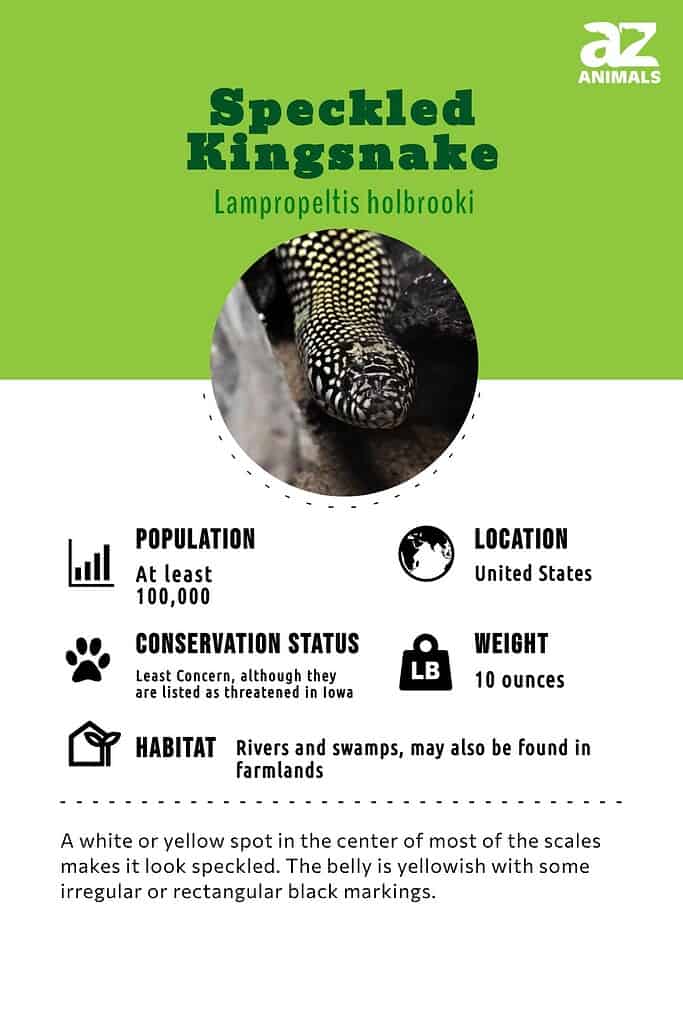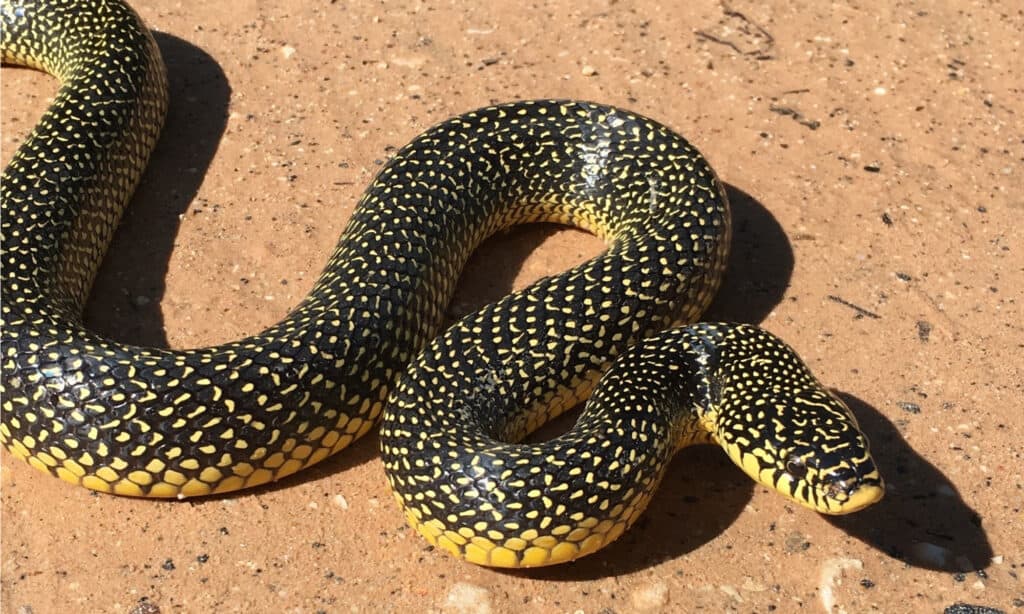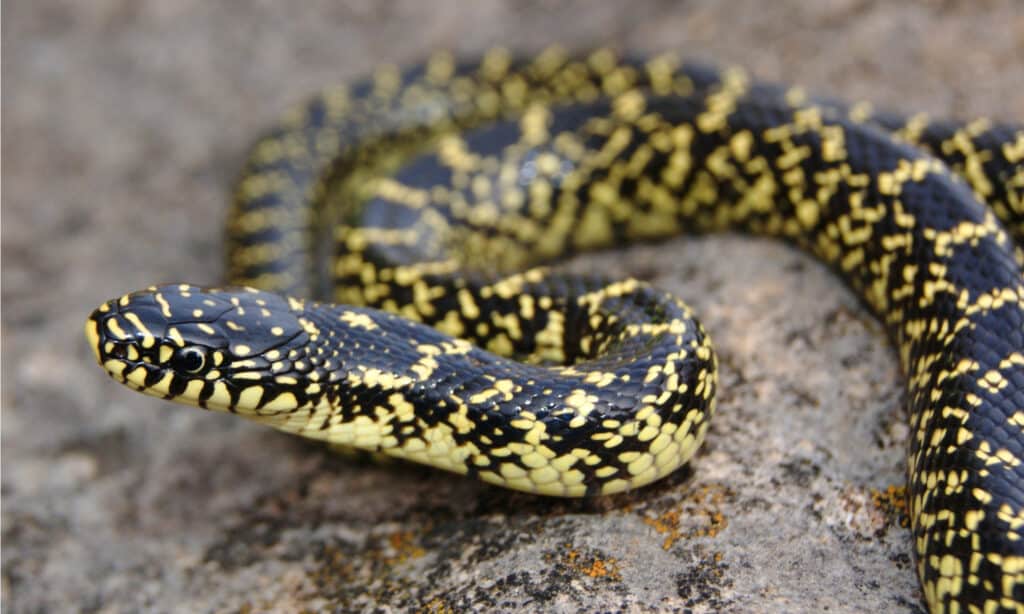Speckled Kingsnake
Lampropeltis holbrooki
The Salt and Pepper Snake
Advertisement
Speckled Kingsnake Scientific Classification
- Kingdom
- Animalia
- Phylum
- Chordata
- Class
- Reptilia
- Order
- Squamata
- Family
- Colubridae
- Genus
- Lampropeltis
- Scientific Name
- Lampropeltis holbrooki
Read our Complete Guide to Classification of Animals.
Speckled Kingsnake Conservation Status
Speckled Kingsnake Facts
View all of the Speckled Kingsnake images!
“The Salt and Pepper Snake”
The elusive speckled kingsnake is one of the prettier members of its genus with its sleek black scales speckled with yellow-white. Though it may be tetchy and combative at first, it can settle down and become a docile and interesting pet that’s easy to take care of. Read on to learn more about the speckled kingsnake.
Four Amazing Facts About Speckled Kingsnakes
Here are four facts about the Speckled Kingsnake.
- Though speckled kingsnakes are prized for the beauty of their salt and pepper coloration, albino snakes are also kept as pets. The speckles on these albino kingsnakes are golden against a pearly, pinkish-white background.
- The snake is considered threatened in Iowa.
- Some biologists believe the speckled kingsnake is a subspecies of the common kingsnake, Lampropeltis getula and classify it as Lampropeltis getula holbrooki.
- The speckled kingsnake is a colubrid, a huge family of mostly nonvenomous snakes.

Where To Find Speckled Kingsnakes
Speckled kingsnakes are found in the United States, from Iowa and Nebraska down through Missouri, Mississippi, Alabama, Arkansas, Louisiana, and west-central Texas to the Gulf of Mexico. Though it’s sometimes seen in drier habitats, the speckled kingsnake prefers habitats around bodies of water such as rivers and swamps and can also be found in farmlands, barns, and trash dumps in search of its favorite prey. As it is a bit secretive, the speckled kingsnake can be found under rocks, boards, and in rotting tree stumps or logs. It’s sometimes found in the burrows of small mammals.
Scientific Name
The snake’s scientific name is Lampropeltis holbrooki. Lampropeltis comes from the Greek words for lampris, which means “shiny” and pelte, which means “shield.” This describes the smooth, nearly porcelain-like texture of the scales on top of the snake’s body. Holbrooki was given in honor of John Edwards Holbrook, an American herpetologist. The snake is a “king” snake because it has other snakes as part of its diet, much like the king cobra. There are no subspecies.
Evolution And Origin
The speckled kingsnake was first discovered in 1842 by American herpetologist John Edwards Holbrook, although as a reptile, the ancestry of the snake dates back further than that. The very first reptile was an amniote, which is any group of animals that undergo embryonic or fetal development within an amnion, and appeared 350 million years ago, during the late Paleozoic era. These amniotes later split into two groups – the synapsids and the sauropsids, which are reptiles. The mass extinction of 245 million years ago wiped out the sauropsids.
All modern snakes can be traced back to around 66 million years ago, during the Cretaceous period. They were able to survive the asteroid impact by their ability to live underground and refrain from eating for long periods of time.
The Different Types Of Speckled Kingsnake
The speckled kingsnake belongs to the family of kingsnakes called Lampropeltis. This genus has 9 different varieties of kingsnakes, of which 6 have their own subspecies. Some of these kingsnakes are:
- California Kingsnake (Lampropeltis getula californiae)
- Common Kingsnake (Lampropeltis getula)
- Scarlet Kingsnake (Lampropeltis elapsoides)
- Gray-banded Kingsnake (Lampropeltis alterna)
- Greer’s Kingsnake (Lampropeltis greeri)
Though there are no subspecies of speckled kingsnake, it’s been known to mate with the desert kingsnake as their geographical ranges and habitats overlap. The snake is also bred for the pet trade and now and then an albino specimen can be had.
Appearance And Description

©Joe Farah/Shutterstock.com
The speckled kingsnake is a medium-sized snake that normally grows to about 4 feet in length, though if it is given good care it can grow a bit longer. The weight ranges between 3 to 5 pounds. Its body is glossy black, and most of the scales bear a whitish-yellow dot that gives it its speckled look. Baby speckled kingsnakes have what look like yellow bars across their back. The ventral area is yellowish and may have some black blotches, and the head is not very distinct from the animal’s neck.
How Dangerous Are They?

©Marina Kehl/Shutterstock.com
Speckled kingsnakes are nonvenomous, but if they’re handled they might vibrate their tail to imitate a rattlesnake, evacuate their bowels, or try to bite. But the snake is sometimes kept as a pet because it can get used to being handled and because of its unusual beauty.
Behavior And Humans

©Matt Jeppson/Shutterstock.com
The speckled kingsnake is secretive and spends much of its time hidden in stumps, under the duff, or under wooden planks. It is active by day from early spring to mid-autumn, and it can sometimes be found basking on cooler days to warm itself up. When the temperature becomes too hot during the day, it will become nocturnal. The snake also enters a period of dormancy in the winter and spends the cold season in caves or burrows already excavated by small mammals. Unlike the common kingsnake, the speckled kingsnake isn’t a good climber of trees. The snake’s conservation status is least concern, and conservationists believe there are at least 100,000 speckled kingsnakes in the United States as of 2022.
The snake’s diet is varied and is made up of rodents and other small size mammals, birds, lizards, frogs, and, as its name states, other snakes. It will even take the highly venomous cottonmouth and copperhead snakes as well as rattlesnakes, for it is immune to their venom. The speckled kingsnake kills its prey by constriction, then swallows it whole.
In the wild, the speckled kingsnake is beneficial to humans and the ecosystem in general because it eats rats and mice and keeps the populations of frogs and other snakes, including venomous ones, in balance. On the other hand, the speckled kingsnake is prey for bigger snakes, birds of prey, skunks, raccoons, opossums, and alligators such as those found in the bayous of Louisiana.
Reproduction And Babies

Female Speckled Kingsnakes can lay between 6 and 23 eggs at one time.
©Creeping Things/Shutterstock.com
The snake mates in April or May in much of its range, and it takes about 60 days for the eggs to hatch. Females can lay between six and 23 eggs in rotting stumps or logs, and these eggs can have multiple fathers. She may lay more than one clutch a year. Neither parent guards the eggs or baby snakes. Females are ready to breed when they’re two to four years old, while males are ready when they’re between one and four years old. The lifespan of this snake can be over 20 years, which is a long lifespan for a snake of its size.
The speckled kingsnake also makes a fascinating pet if it is given good care. Because they like to hide in the wild, they’ll need to be given some kind of place to hide in their enclosure, which should hold between 29 and 40 gallons. The temperature should be between 84 and 90 degrees Fahrenheit by day and lowered to between 68 and 75 degrees F at night. The substrate can be bark or pine shavings or other loose material the snake can burrow under. The enclosure should never be placed in direct sunlight which can cause the snake to overheat and die. The snake should also not be kept with other snakes because, as has been seen, it will eat them.
Speaking of the snake’s diet, a pet snake should be fed baby mice when it’s young and grown mice when it is fully grown. Snakes only need to be fed once a week, and they should not be fed or handled at all when it’s about to shed their skin.
View all 306 animals that start with SSpeckled Kingsnake FAQs (Frequently Asked Questions)
How big do speckled kingsnakes get?
Speckled kingsnakes usually get to about 4 feet in length, but at least one grew to 6 feet.
Are speckled king snakes protected?
The speckled kingsnake is protected in some areas. In Alabama, it is illegal to sell, buy or capture a speckled king snake. It’s also considered threatened in Iowa even though its overall conservation status is least concern.
What do speckled king snakes eat?
Speckled ling snakes eat other snakes, including venomous ones such as the cottonmouth. They also eat small mammals. lizards, birds, and frogs.
Can a speckled kingsnake kill you?
A speckled kingsnake is nonvenomous and can’t kill you, but it might put up a fight at first if you handle it.
Where are speckled kingsnakes found?
Speckled kingsnakes are found in the middle and the southern part of the United States. This includes states such as Iowa and Nebraska and down to Arkansas, Louisiana, Georgia, Alabama, Texas, and Oklahoma.
Thank you for reading! Have some feedback for us? Contact the AZ Animals editorial team.
Sources
- Wikipedia / Accessed May 7, 2022
- Missouri Department of Conservation / Accessed May 7, 2022
- The Reptile Database / Accessed May 7, 2022
- Natural World Pets / Accessed May 7, 2022
- Repti Pro / Accessed May 7, 2022
- IUCN Redlist / Accessed May 7, 2022
- The News Courier / Accessed May 7, 2022
- Live Science / Accessed May 7, 2022




















